Relationship between Nanomechanical Responses of Interfacial Intermetallic Compound Layers and Impact Reliability of Solder Joints
Abstract
:1. Introduction
2. Experimental Procedures
3. Results and Discussion
4. Conclusions
Author Contributions
Funding
Acknowledgments
Conflicts of Interest
References
- Song, J.M.; Liu, Y.R.; Lai, Y.S.; Chiu, Y.T.; Lee, N.C. Influence of trace alloying elements on the ball impact test reliability of SnAgCu solder joints. Microelectron. Reliab. 2012, 52, 180–189. [Google Scholar] [CrossRef]
- Song, J.M.; Lin, M.J.; Hsieh, K.H.; Pai, T.Y.; Lai, Y.S.; Chiu, Y.T. Ball impact reliability of Zn-Sn high temperature solder joints bonded with different substrates. J. Electron. Mater. 2013, 42, 2813–2821. [Google Scholar] [CrossRef]
- Yang, P.F.; Lai, Y.S.; Jian, S.R.; Chen, J.; Chen, R.S. Nanoindentation indentifications of mechanical properties of Cu6Sn5, Cu3Sn and Ni3Sn4 intermetallic compounds derived by diffusion couples. Mater. Sci. Eng. A 2007, 485, 305–310. [Google Scholar] [CrossRef]
- Deng, X.; Chawla, N.; Chawla, K.K.; Koopman, M. Deformation behavior of (Cu,Ag)-Sn intermetallics by nanoindentation. Acta Mater. 2004, 52, 4291–4303. [Google Scholar] [CrossRef]
- Chromik, R.R.; Wang, D.N.; Shugar, A.; Limata, L.; Notis, M.R.; Vinci, R.P. Mechanical properties of intermetallic compounds in the Au-Sn system. J. Mater. Res. 2005, 20, 2161–2172. [Google Scholar] [CrossRef]
- Lucas, J.P.; Rhee, H.; Subramanian, K.N. Mechanical properties of intermetallic compounds associated with Pb-Free solder joints using nanoindentation. J. Electron. Mater. 2003, 32, 1375–1383. [Google Scholar] [CrossRef]
- Song, J.M.; Liu, Y.R.; Su, C.W.; Lai, Y.S.; Chiu, Y.T. Intermetallic formation induced substrate dissolution in electroless Ni(P)-solder interconnections. J. Mater. Res. 2008, 23, 2545–2554. [Google Scholar] [CrossRef]
- Fisher-Cripps, A.C. Nanoindentation; Springer: New York, NY, USA, 2004. [Google Scholar]
- Song, J.M.; Shen, Y.L.; Su, C.W.; Lai, Y.S.; Chiu, Y.T. Strain rate Dependence on Nanoindentation Responses of Interfacial Intermetallic Compounds in Electronic Solder Joints with Cu and Ag Substrates. Mater. Trans. 2009, 50, 1231–1234. [Google Scholar] [CrossRef] [Green Version]
- Song, J.M.; Su, C.W.; Lai, Y.S.; Chiu, Y.T. Time Dependent Deformation Behavior of Interfacial Intermetallic Compound Layers in Electronic Solder Joints. J. Mater. Res. 2010, 25, 629–632. [Google Scholar] [CrossRef]
- Song, J.M.; Huang, B.R.; Liu, C.Y.; Lai, Y.S.; Chiu, Y.T.; Huang, T.W. Nanomechanical Responses of Intermetallic Phase at the Solder Joint Interface—Crystal Orientation and Metallurgical Effects. Mater. Sci. Eng. A 2012, 534, 53–59. [Google Scholar] [CrossRef]
- Song, J.M.; Lu, W.C.; Chou, P.W. Nanomechanical responses of intermetallic compound layer in transient liquid phase bonding using indium. J. Electron. Mater. 2020, 49, 18–25. [Google Scholar] [CrossRef]
- Yu, J.J.; Wu, J.Y.; Yu, L.J.; Yang, H.W.; Kao, C.R. Micromechanical Behavior of Single-Crystalline Cu6Sn5 by Picoindentation. J. Mater. Sci. 2017, 52, 7166–7174. [Google Scholar] [CrossRef]
- Randle, V.; Powell, G.L.F. The effect of Si on the relationship between orientation and carbide morphology in high chromium white iron. J. Mater. Sci. 1997, 32, 561–565. [Google Scholar]
- Oliver, W.C.; Pharr, G.M. An improved technique for determining hardness and elastic modulus using load and displacement sensing indentation experiments. J. Mater. Res. 1992, 7, 1564–1583. [Google Scholar] [CrossRef]
- Lai, Y.S.; Chang, H.C.; Yeh, C.L. Evaluation of solder joints strengths under ball impact test. Microelectron. Reliab. 2007, 47, 2179–2187. [Google Scholar] [CrossRef]
- Lai, Y.S.; Yang, P.F.; Yeh, C.L. Experimental studies of board-level reliability of chip-scale packages subjected to JEDEC drop test condition. Microelectron. Reliab. 2006, 46, 645–650. [Google Scholar] [CrossRef]
- Lai, Y.S.; Song, J.M.; Chang, H.C.; Chiu, Y.T. Ball impact responses of Ni- or Ge-doped Sn-Ag-Cu solder joints. J. Electron. Mater. 2008, 37, 201–209. [Google Scholar] [CrossRef]
- Yeh, C.L.; Lai, Y.S.; Chang, H.C.; Chen, T.H. Empirical correlation between package-level ball impact test and board-level drop reliability. Microelectron. Reliab. 2007, 47, 1127–1134. [Google Scholar] [CrossRef]
- Yang, S.C.; Chang, C.C.; Tsai, M.H.; Kao, C.R. Effect of Cu concentration, solder volume, and temperature on the reaction between SnAgCu solders and Ni. J. Alloy. Comp. 2010, 499, 149–153. [Google Scholar] [CrossRef]
- Ho, C.E.; Lin, Y.L.; Kao, C.R. Strong effect of Cu concentration on the reaction between lead-free microelectronic solders and Ni. Chem. Mater. 2002, 14, 949–951. [Google Scholar] [CrossRef]
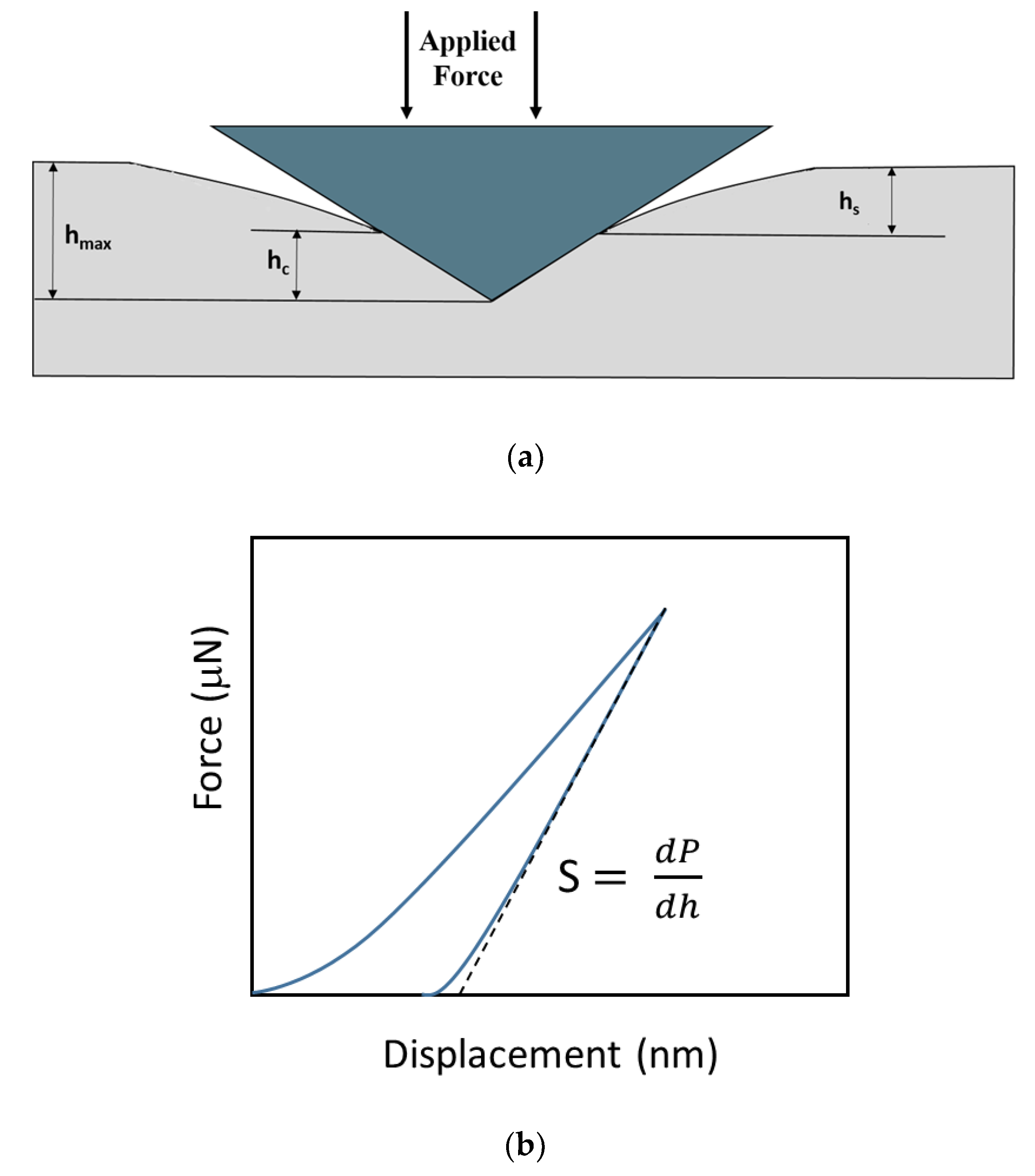
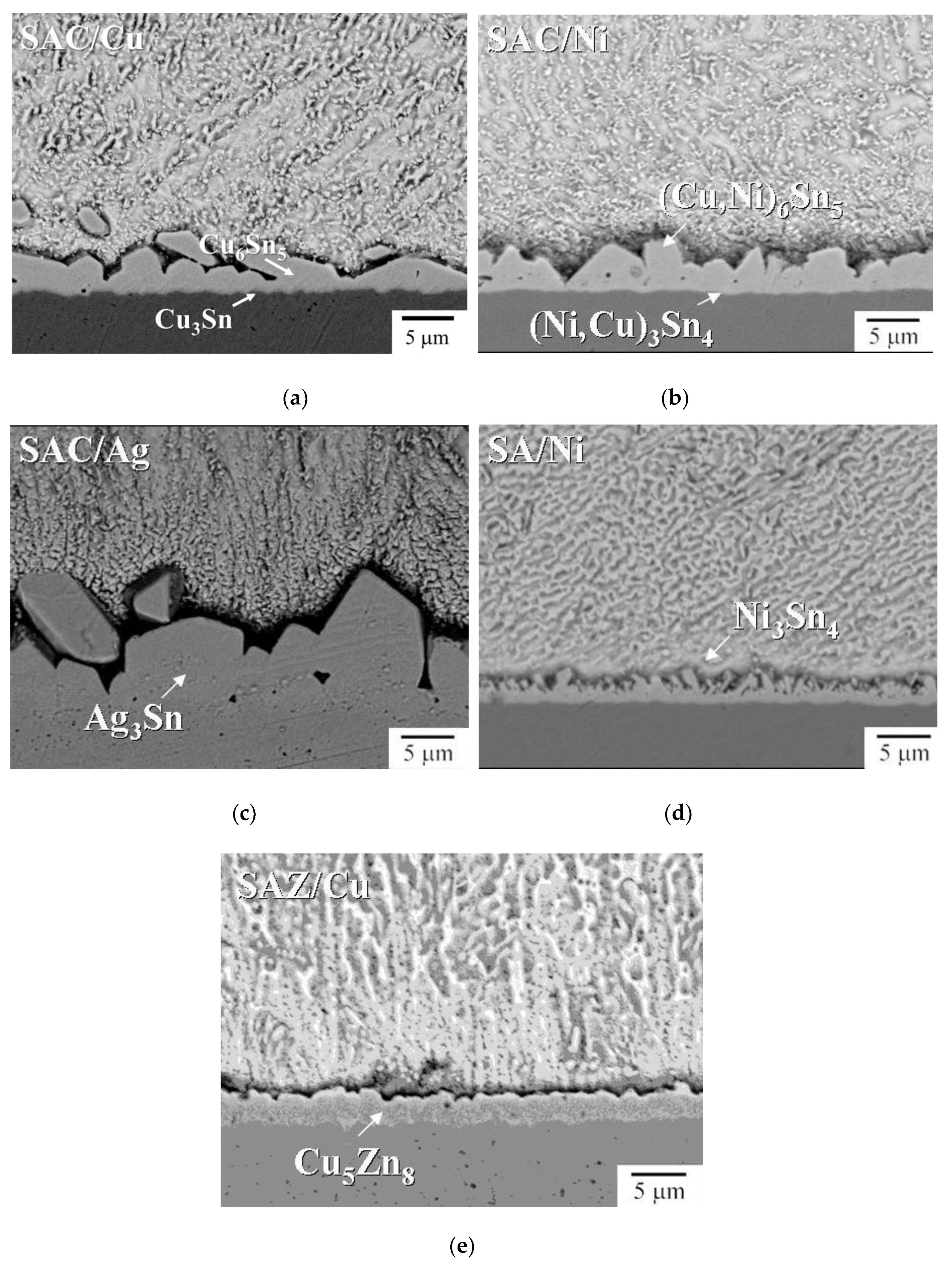
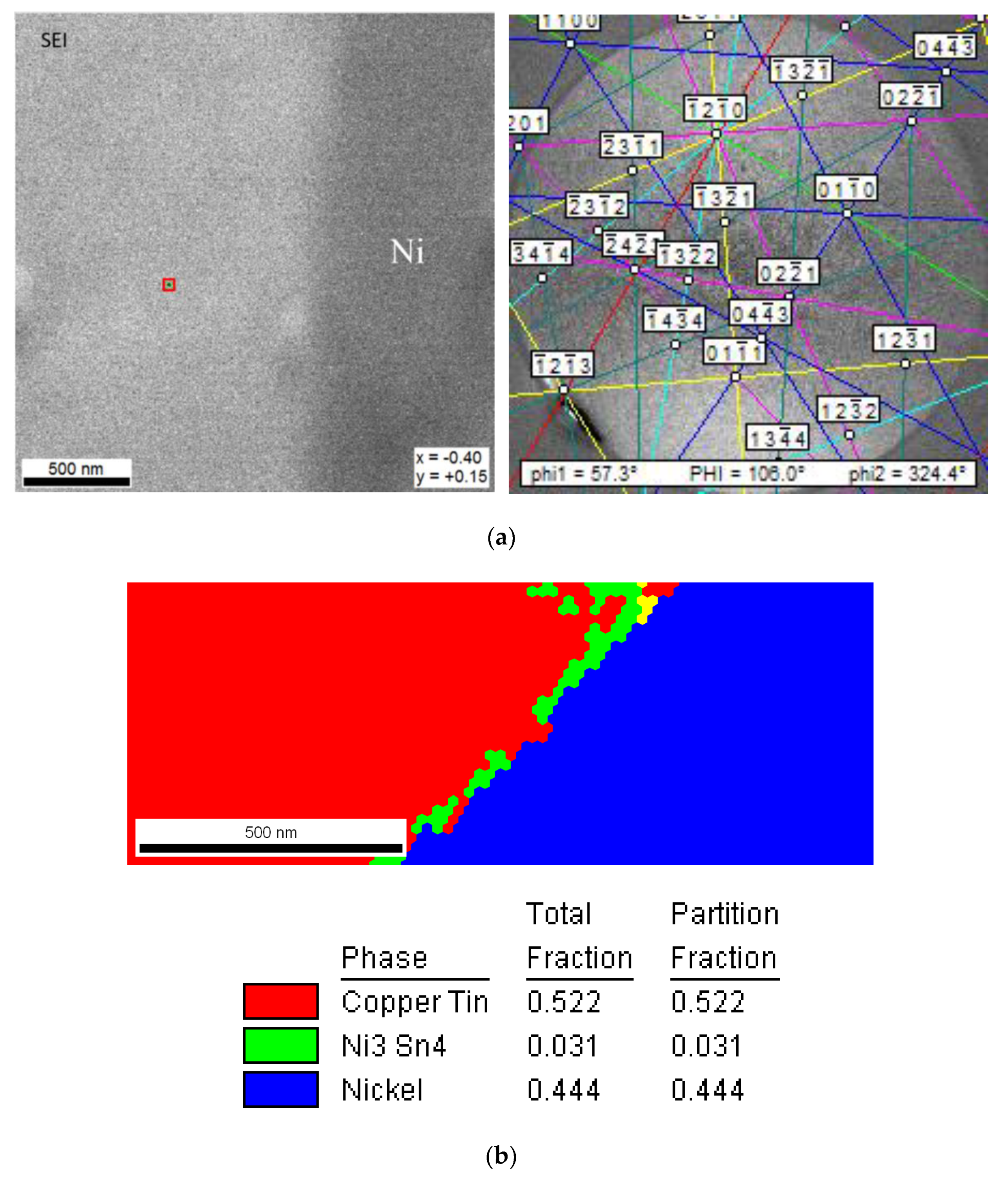
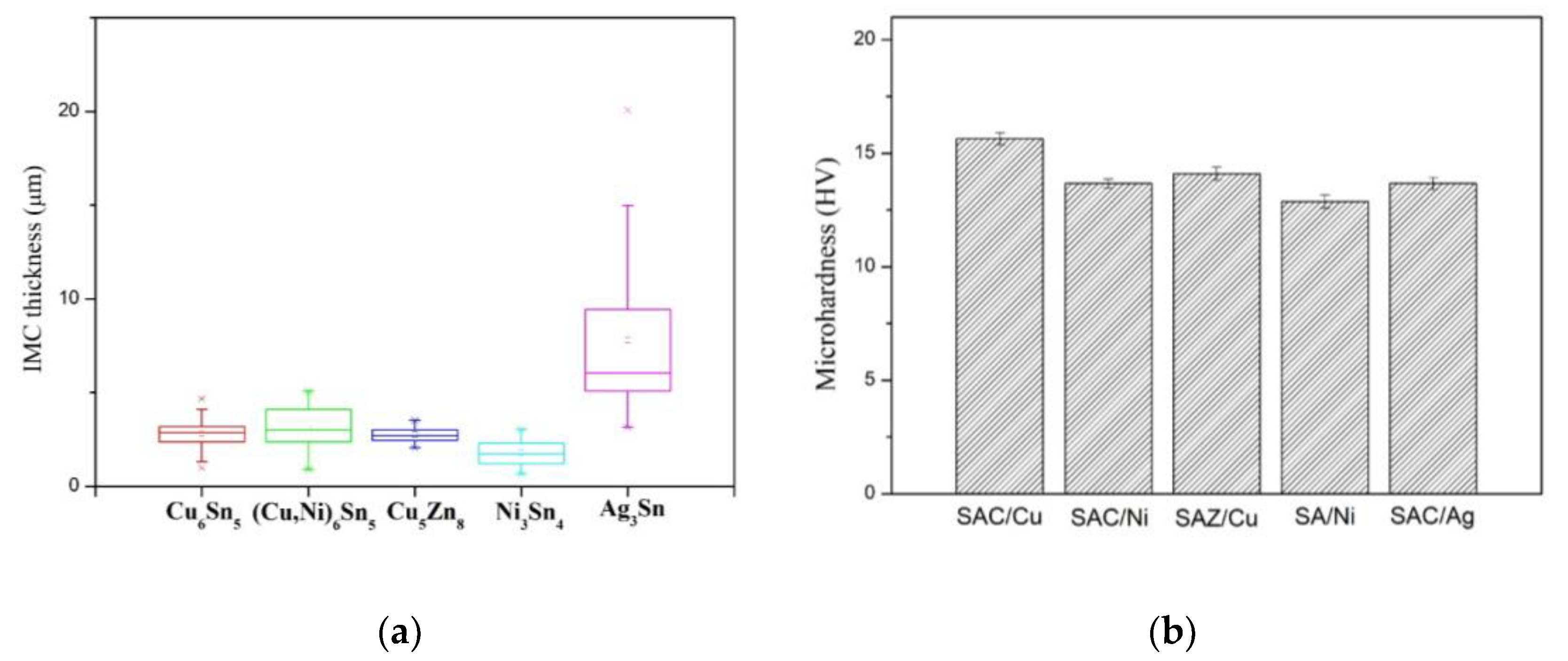
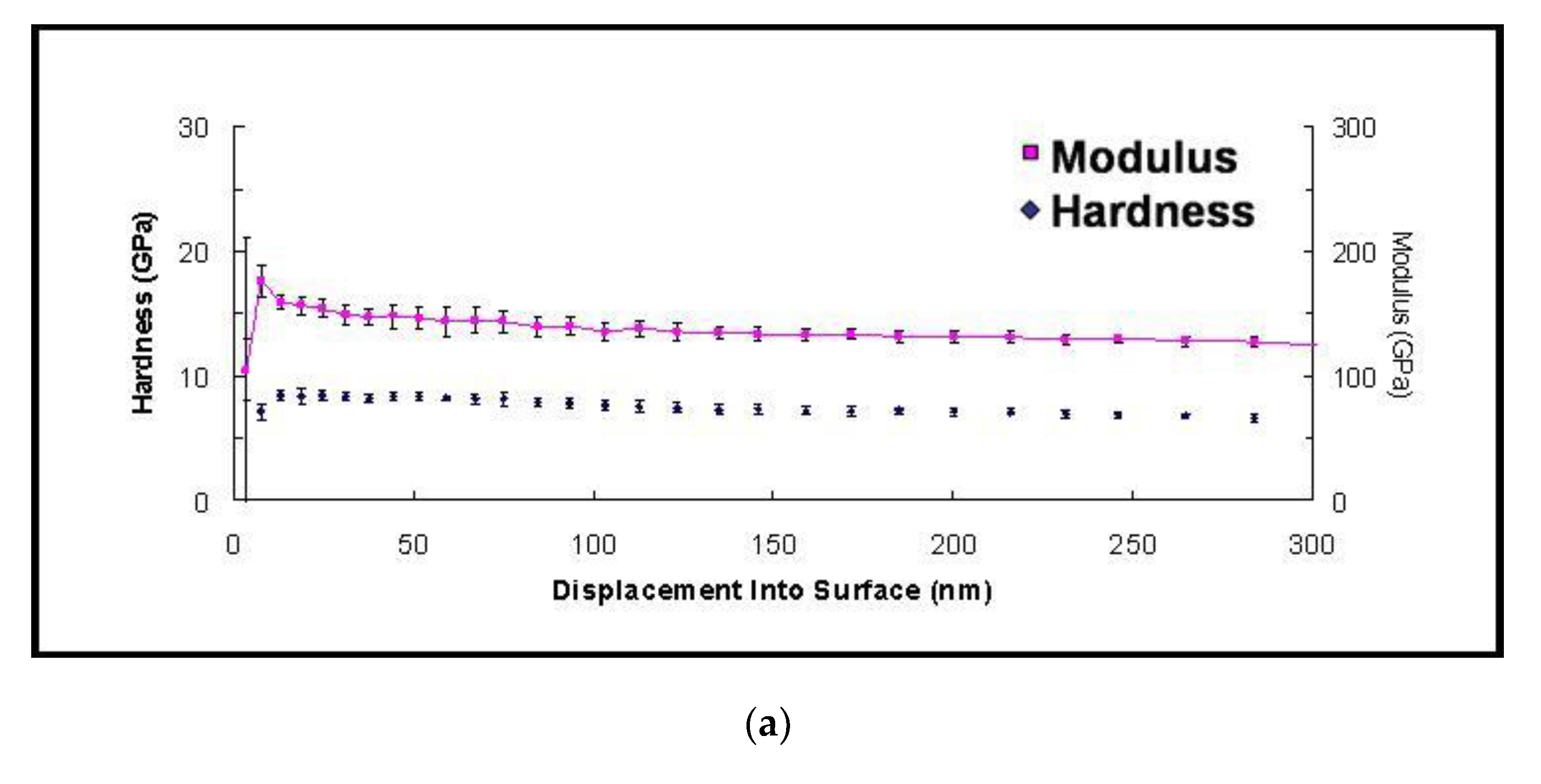
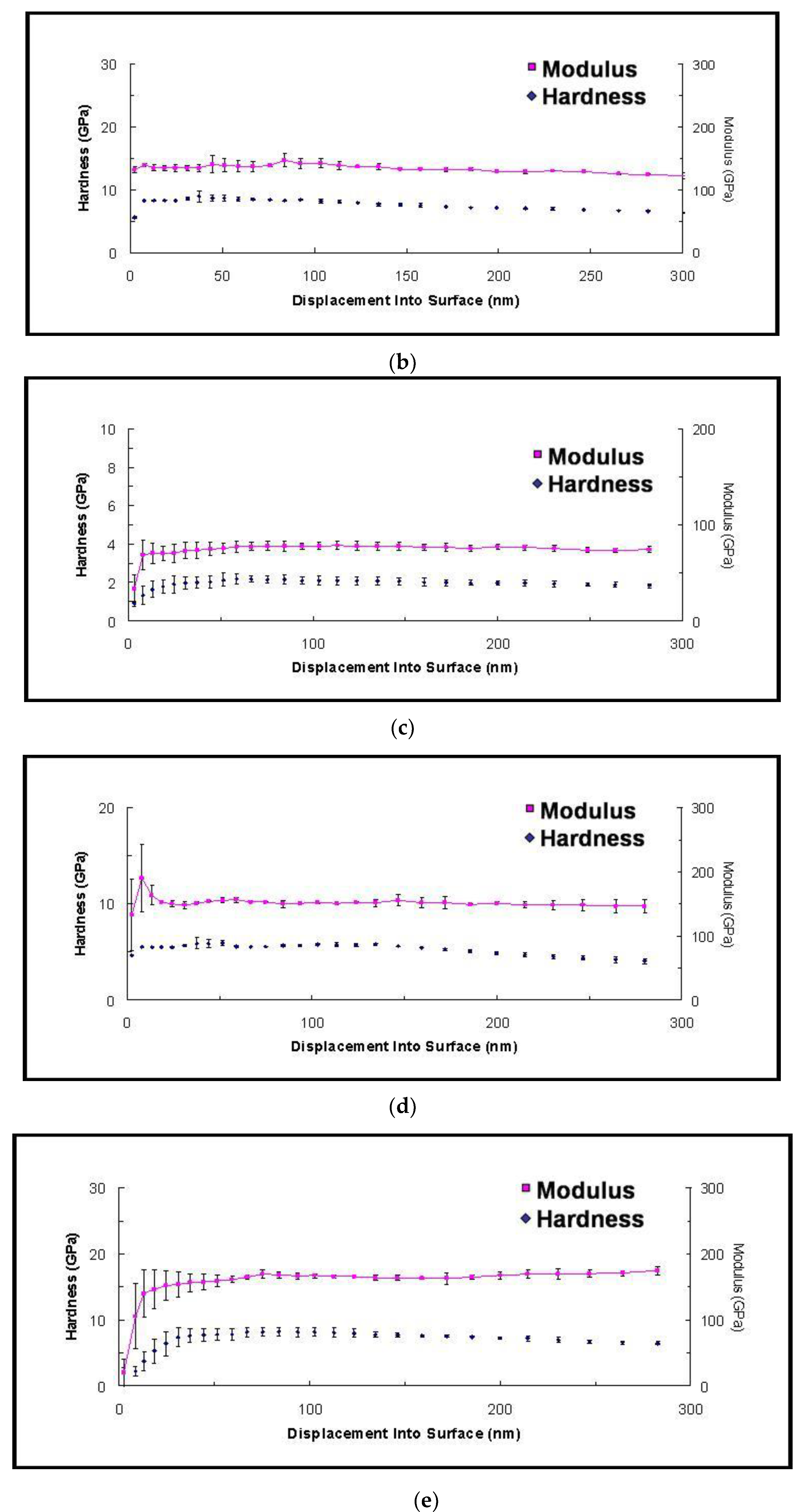

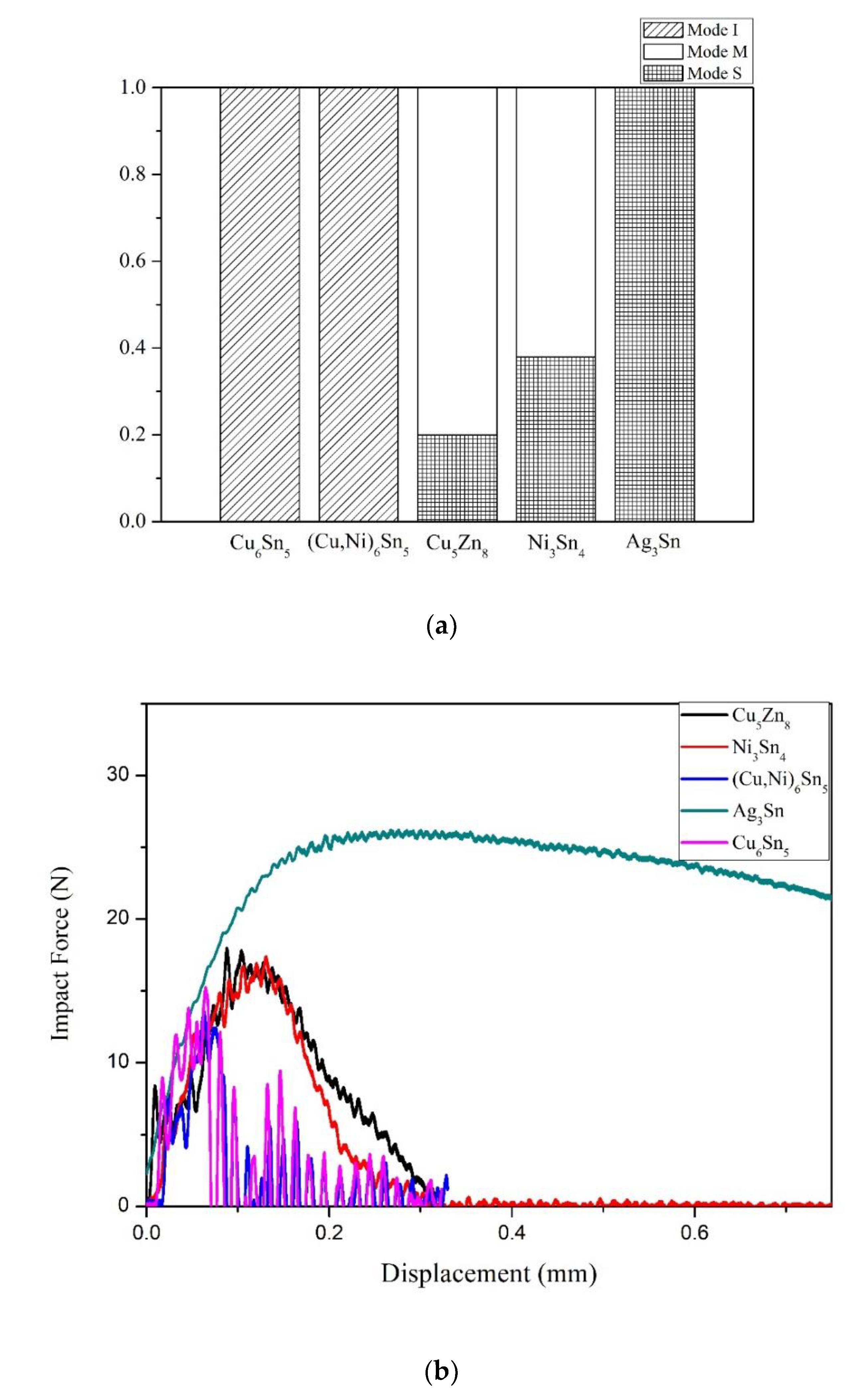
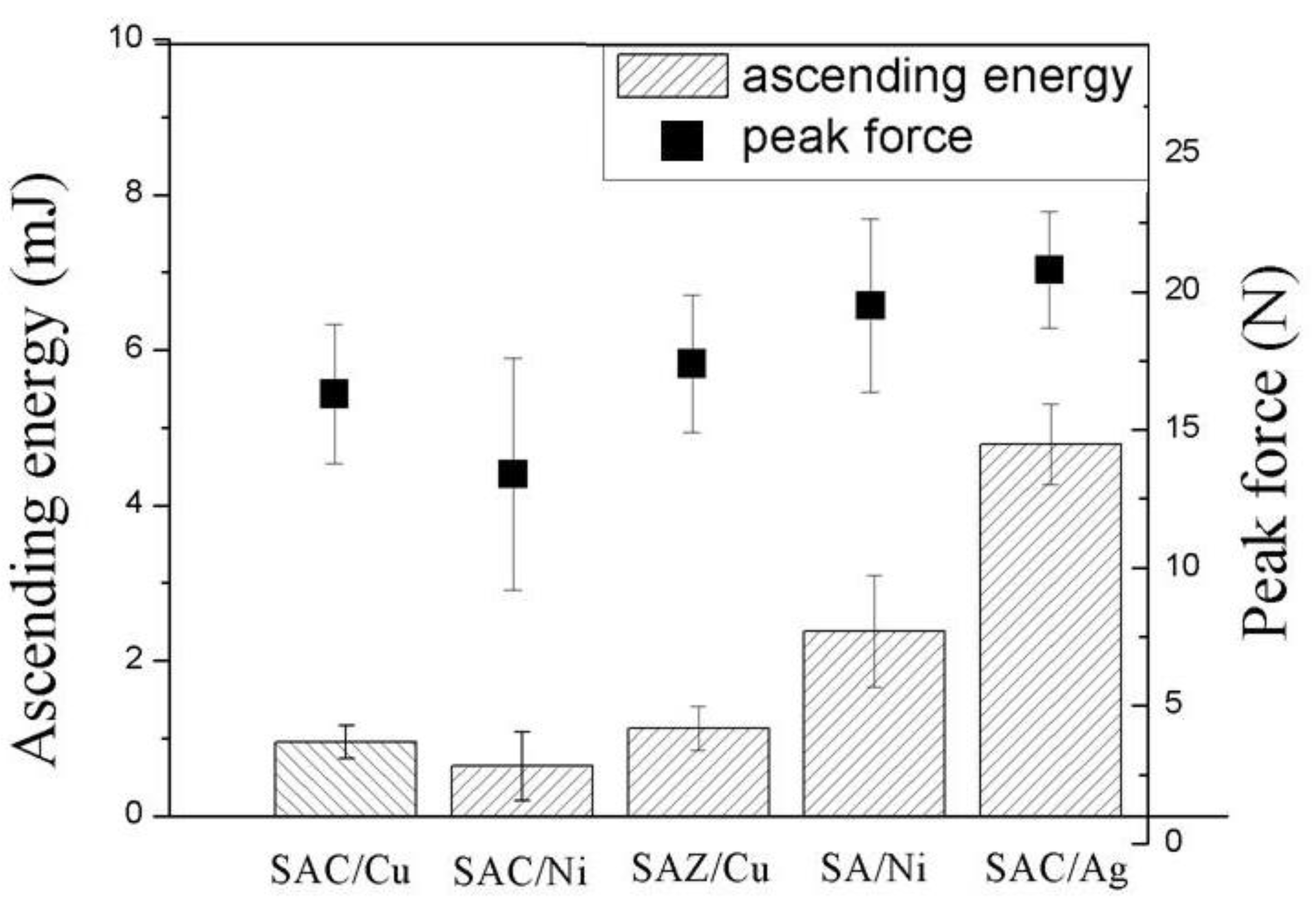
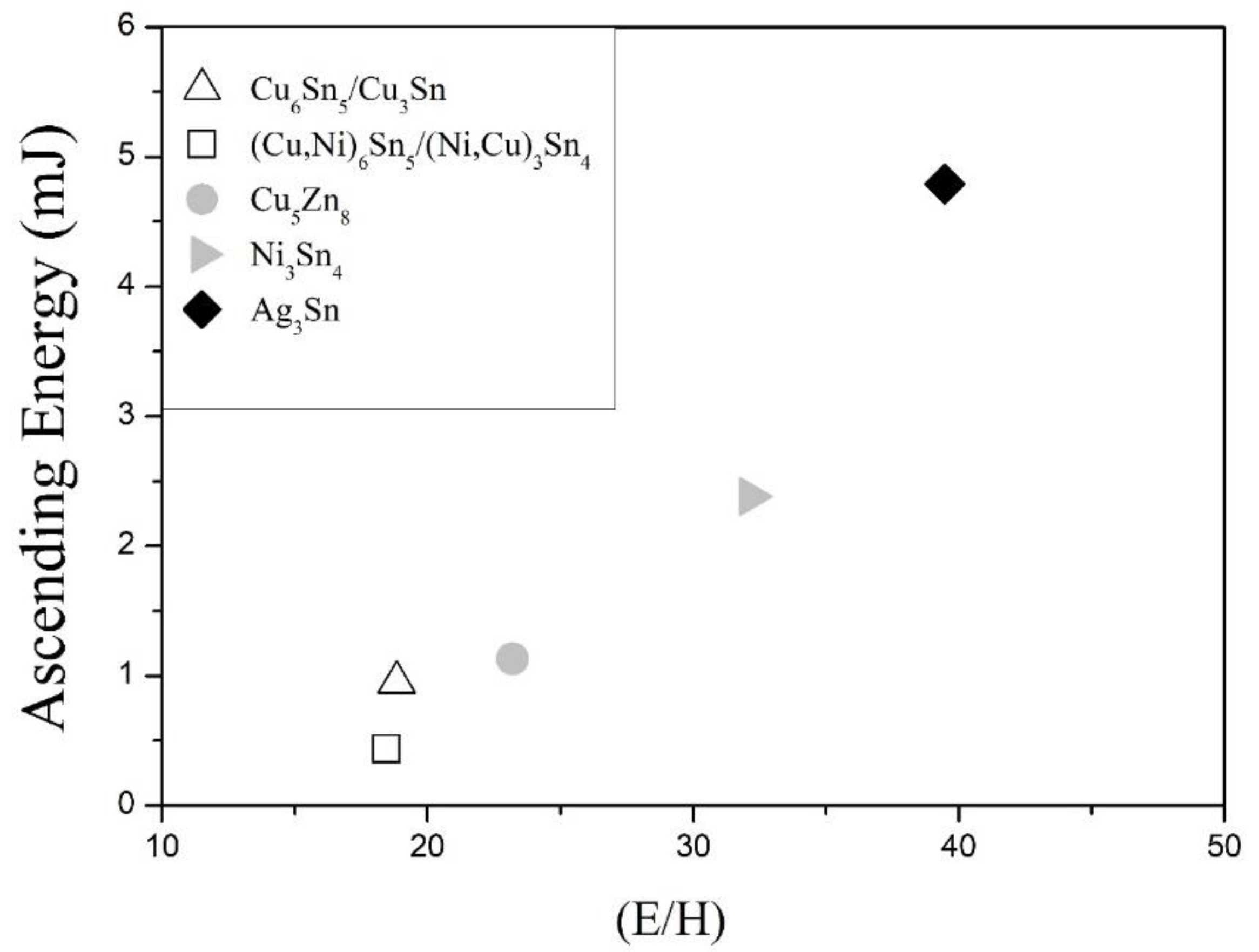

| IMC/Composition | Sn | Ag | Cu | Ni | Zn |
|---|---|---|---|---|---|
| Cu6Sn5 | 44.2 | --- | 55.3 | --- | --- |
| (Cu,Ni)6Sn5 | 42.6 | --- | 40.7 | 16.7 | --- |
| Ag3Sn | 26.6 | 73.4 | --- | --- | --- |
| Ni3Sn4 | 59.9 | --- | --- | 40.2 | --- |
| Cu5Zn8 | --- | 3.0 | 40.6 | --- | 56.4 |
| H (GPa) | E (GPa) | E/H | |
|---|---|---|---|
| Cu6Sn5 | 6.9 ± 0.22 | 130 ± 3.9 | 18.9 |
| (Cu,Ni)6Sn5 | 7.0 ± 0.15 | 129 ± 1.3 | 18.5 |
| Ag3Sn | 1.9 ± 0.14 | 75 ± 2.6 | 39.5 |
| Ni3Sn4 | 4.6 ± 0.19 | 148 ± 4.2 | 32.2 |
| Cu5Zn8 | 7.0 ± 0.32 | 169 ± 3.3 | 24.1 |
© 2020 by the authors. Licensee MDPI, Basel, Switzerland. This article is an open access article distributed under the terms and conditions of the Creative Commons Attribution (CC BY) license (http://creativecommons.org/licenses/by/4.0/).
Share and Cite
Song, J.-M.; Huang, B.-C.; Tarng, D.; Hung, C.-P.; Yasuda, K. Relationship between Nanomechanical Responses of Interfacial Intermetallic Compound Layers and Impact Reliability of Solder Joints. Nanomaterials 2020, 10, 1456. https://doi.org/10.3390/nano10081456
Song J-M, Huang B-C, Tarng D, Hung C-P, Yasuda K. Relationship between Nanomechanical Responses of Interfacial Intermetallic Compound Layers and Impact Reliability of Solder Joints. Nanomaterials. 2020; 10(8):1456. https://doi.org/10.3390/nano10081456
Chicago/Turabian StyleSong, Jenn-Ming, Bo-Chang Huang, David Tarng, Chih-Pin Hung, and Kiyokazu Yasuda. 2020. "Relationship between Nanomechanical Responses of Interfacial Intermetallic Compound Layers and Impact Reliability of Solder Joints" Nanomaterials 10, no. 8: 1456. https://doi.org/10.3390/nano10081456







